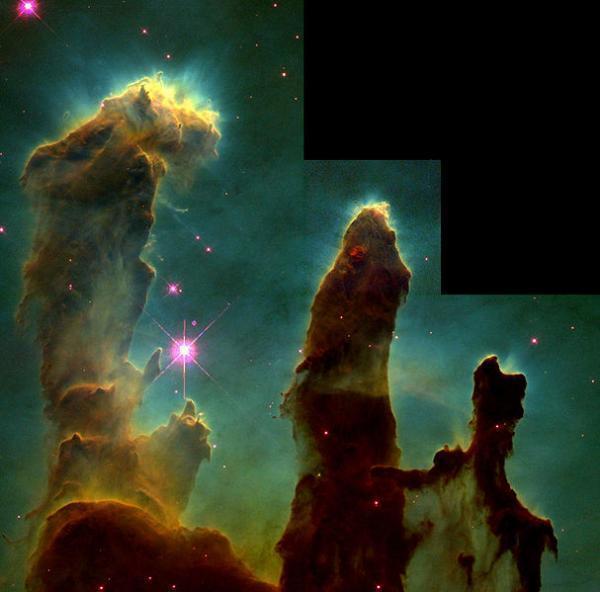Research by astronomers at the Dublin Advanced Research Institute shows that shadows that hold the key in how to form giant star-forming structures are like 'Creative Columns'.
These pillars are dense clouds of dust and gas where giant stars form. Several hypotheses have been proposed to explain why they form at the edge of ionized air bubbles surrounding young and very hot stars. Using the computer model, the Dublin team found that the partially covered gas columns tend to move toward darker areas, causing overlapping phenomena behind dusty gas nodes. dense cover ultra-strong ultraviolet light emitted by stars.
Jonathan Mackey, who announced the results at the European Astronomical and Astrophysics conference held at Hatfield, said: 'We created a simulation by randomly distributing gas clouds. Dense dust with different sizes and shapes. We found that in certain cases the clouds combined together in the dark to form pillar-like structures. They are dense enough as the picture looks, they can be formed in about 150,000 years and last about 100,000 years. Although this is just a preliminary study, we believe this result is quite accurate and will be confirmed by more detailed models. '
The research team led by Dr. Andrew Lim found that the shape of the gases must be favorable to form the gas column. Some people predict that the gas columns in the Eagle Nebula exist only for less than 100,000 years, and models that show darkness from a cloud of gas will not be able to achieve the density needed to form a gas column in a span of relatively short time.
 The 'Creative Columns' tree in the Eagle Nebula. (Photo: ESA / NASA)
The 'Creative Columns' tree in the Eagle Nebula. (Photo: ESA / NASA)
Lim said: 'Many of the models we conducted cannot create as high and narrow columns of gas as in the Eagle Nebula, at least with the condition of gas as high as the observed. Need to have the shape of dense gas suitable for forming long columns. Unless the covered area is already dense enough for the process to happen, it will take a long time to collect and structure the gas to become a column. '
The research team plans to increase the authenticity of the model over the next few years, thereby creating an accurate representation model for the complex chemical properties of the gas as well as the impact of radiation from diffuse sources. . Taking into account the effect of gravity is also important because the gas columns contain dense masses of gas, which is also in the process of collapse by its own weight to form the next generation of stars. .
Mackey said: 'Gravity is not very important when gas columns form, but at one point they become very dense then we cannot ignore gravity. We plan to include gravity in future studies so that we can find new generations of stars that are forming in the gas column. '
 Van Allen's belt and evidence that the Apollo 11 mission to the Moon was myth
Van Allen's belt and evidence that the Apollo 11 mission to the Moon was myth The levels of civilization in the universe (Kardashev scale)
The levels of civilization in the universe (Kardashev scale) Today Mars, the sun and the Earth are aligned
Today Mars, the sun and the Earth are aligned The Amazon owner announced a secret plan to build a space base for thousands of people
The Amazon owner announced a secret plan to build a space base for thousands of people Satellite detects 'super pollution' that is warming the planet
Satellite detects 'super pollution' that is warming the planet  Decoding the mystery of the giant 'death hole' in Siberia
Decoding the mystery of the giant 'death hole' in Siberia  A death hole appeared in the middle of the galaxy's 'heart' containing Earth
A death hole appeared in the middle of the galaxy's 'heart' containing Earth  I got goosebumps because I discovered hundreds of 'black spiders' on Mars
I got goosebumps because I discovered hundreds of 'black spiders' on Mars  NASA found traces of methane gas near a crater on Mars
NASA found traces of methane gas near a crater on Mars  Top 4 'craziest' biological weapons in human history
Top 4 'craziest' biological weapons in human history 